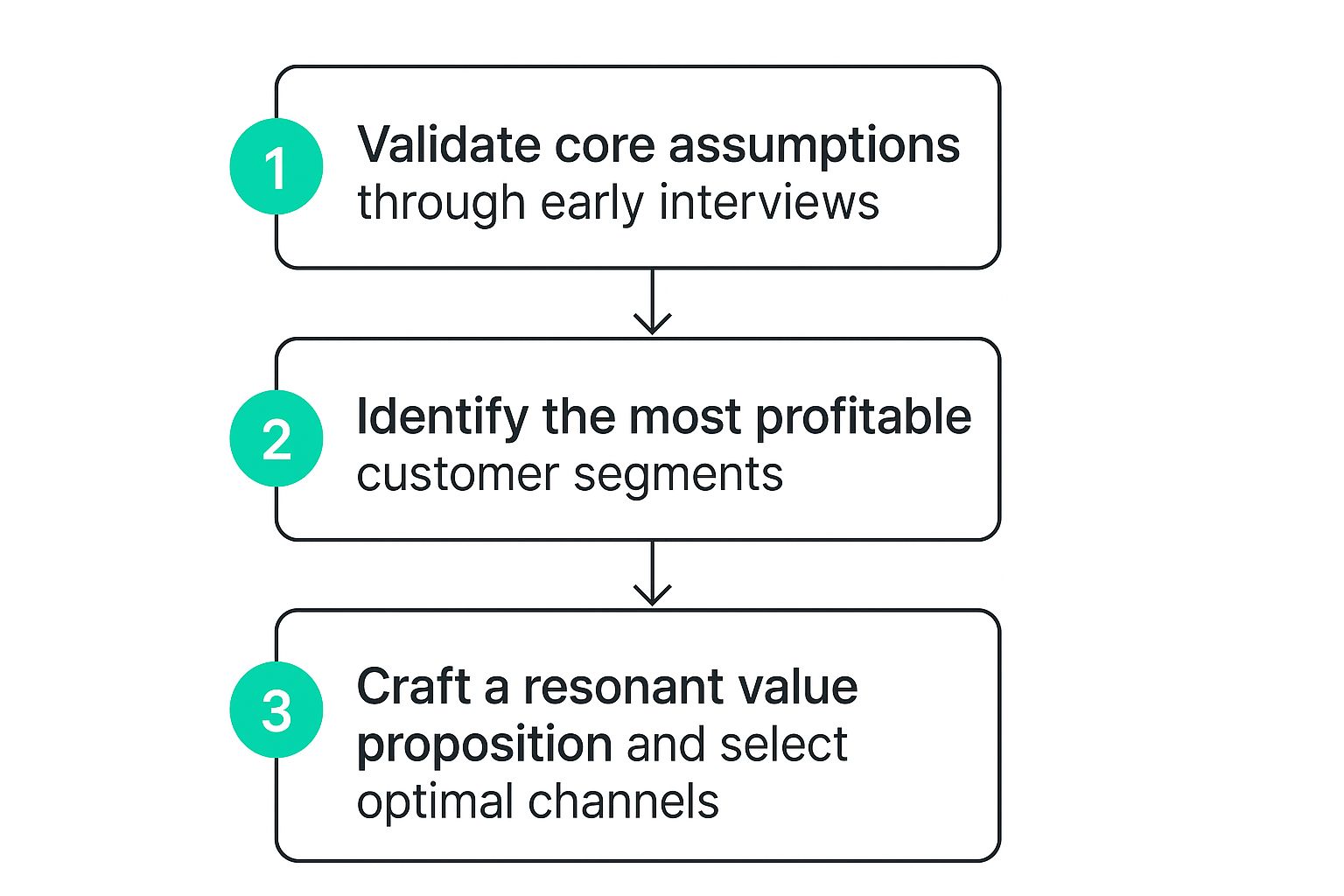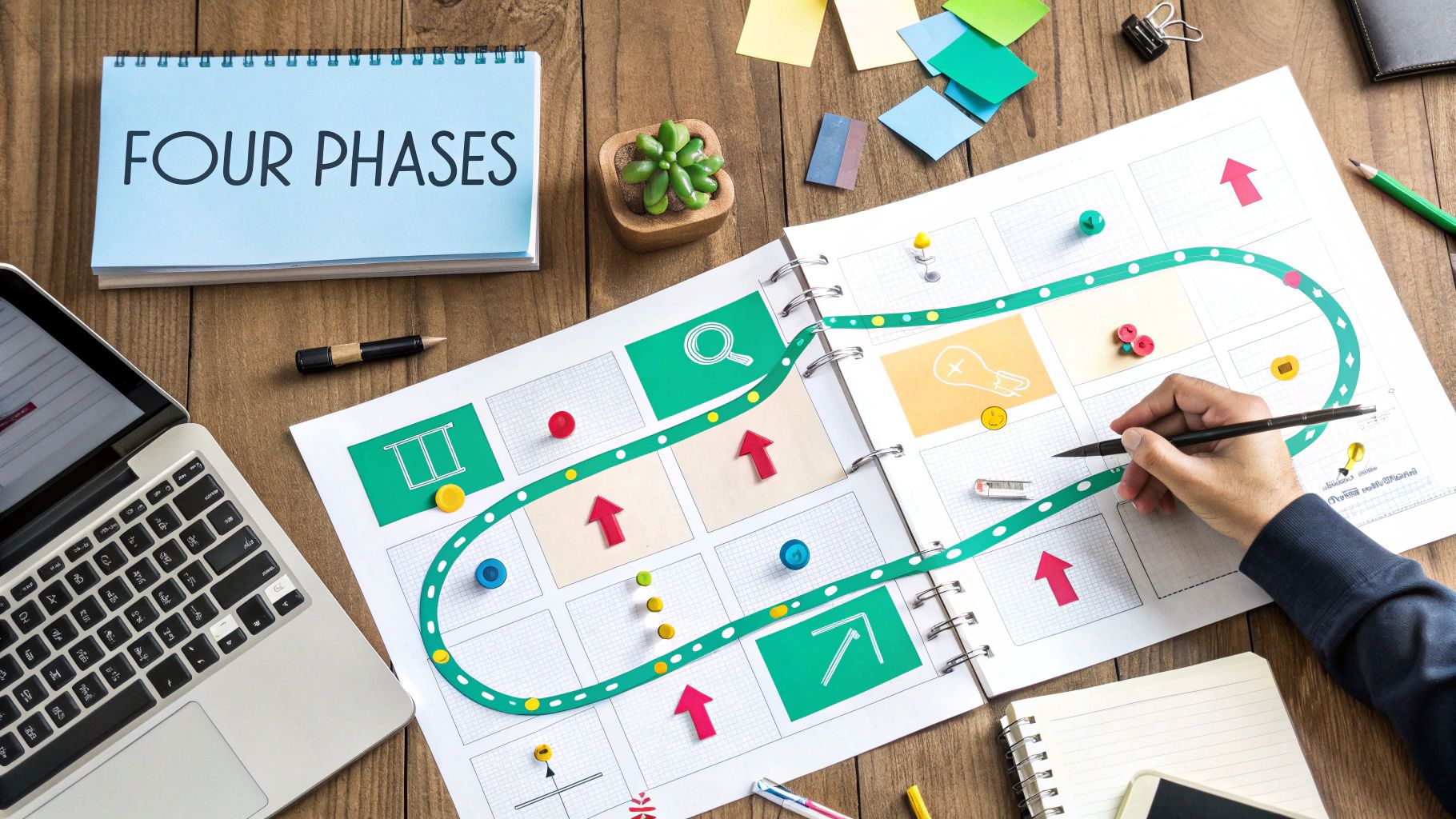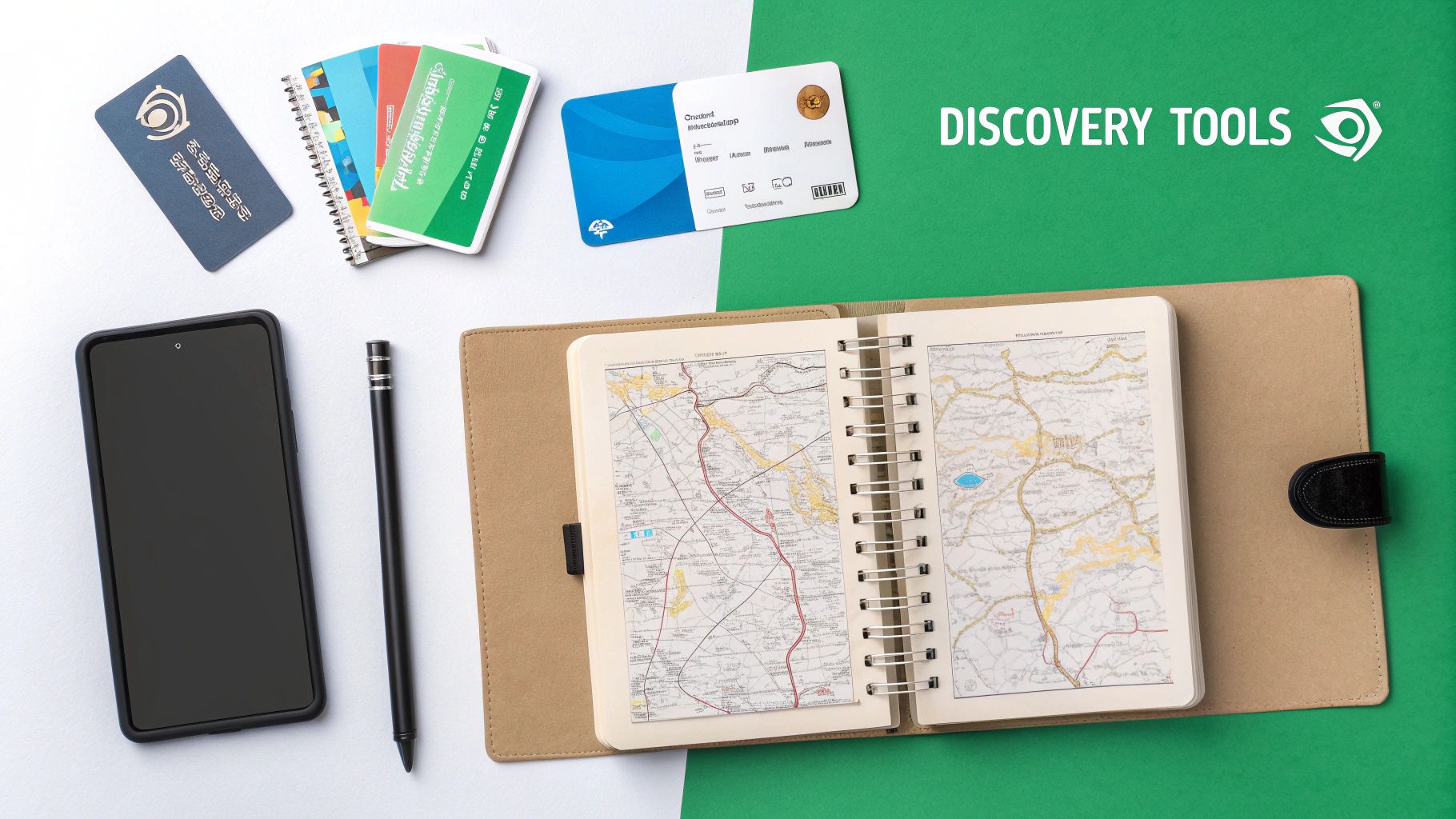What Is Customer Discovery? A Guide to Building Desired Products
Customer discovery is all about getting out of the building and talking to people before you write a single line of code. Think of yourself as a detective working on a business idea. Instead of starting with a product, you start with people, hunting for clues about the real-world problems they face every day.
What Is Customer Discovery Really

Imagine an architect designing a house without ever meeting the family who will live there. They might build something stunning, but it could be missing the home office, the open kitchen, or the extra bedroom the family actually needed. This is exactly how many businesses operate—building solutions in a bubble based on their own assumptions.
Customer discovery flips that old model on its head. It’s a structured process for testing your core business ideas against reality, and you do it by talking directly with potential customers. At its heart, customer discovery is a quest to truly understand customer needs on a deep, fundamental level.
Shifting From Building To Learning
This concept really took off in the early 2000s thanks to Steve Blank, who made it a cornerstone of the Lean Startup methodology. The goal is incredibly simple but powerful: stop building products that nobody wants. A shocking 42% of startups fail because there’s no market need for what they built, a problem customer discovery is designed to prevent.
This process helps you figure out if a problem is painful enough—and if enough people feel that pain—to build a business around it. You can dig into the full research on these startup findings on hbs.edu.
The trick of this isn’t actually figuring out the customer’s pain—the trick is figuring out which customers have the pain that we solve and whether there are enough of them to build a business on.
This mindset shift is everything. Instead of asking, "Can we build this?" the question becomes, "Should we build this?" It forces you to prioritize learning over building and hard evidence over gut feelings.
Customer Discovery vs Traditional Product Development
To really get what customer discovery is all about, it helps to see how it stacks up against the old way of doing things. One is all about conversations and validation; the other is about internal planning and execution. This table breaks down the key differences in how each approach works.
| Aspect | Customer Discovery Approach | Traditional Product Development |
|---|---|---|
| Starting Point | Customer problem or pain point | A product idea or feature list |
| Primary Goal | Learning and validation | Building and shipping a product |
| Key Metric | Validated learning and insights | Features completed, deadlines met |
| Customer Role | A co-creator and source of truth | A recipient of the final product |
| Failure Response | Pivot based on new evidence | Double down or abandon the project |
Ultimately, customer discovery is about humility. It’s admitting you don’t have all the answers and that the truth lies with your customers, not in a conference room.
Why Discovery Is Your Most Important GTM Strategy
A lot of founders think their Go-To-Market (GTM) strategy kicks off the day their product goes live. The truth is, a winning GTM plan is built way before that, and it all starts with customer discovery. This isn't just about tweaking product features; it's the single most important thing you can do to de-risk your entire business.
When you start having these conversations early, you're trading guesswork for actual evidence. Instead of just hoping people will buy what you've built, you're gathering proof that they have a real problem that needs solving. This simple step is the best way to avoid the number one reason startups fail: building something nobody wants.
This infographic breaks down how those early discovery insights become the blueprint for a powerful GTM strategy.

As you can see, it all starts with validating your core ideas with real people. That's the only way to craft a message and a strategy that actually connects with the market.
From Insights To Action
The information you gather isn't just interesting—it's the raw material for your entire launch plan. Think of customer discovery as the critical first chapter in your essential Go To Market Strategy Guide that sets you up for a successful launch.
These conversations give you the details that matter, like:
- Who to target: You'll pinpoint which customer groups feel the pain most deeply and, just as importantly, have the budget to fix it.
- What to say: You'll hear the exact words and phrases your customers use to describe their problems, which is pure gold for your marketing copy.
- Where to find them: You'll learn where your ideal customers spend their time online, so you know exactly where to focus your marketing efforts.
By digging up these insights, you turn your product launch from a shot in the dark into a confident, calculated entry into the market.
De-Risking Your Launch
This whole approach is rooted in the Lean Startup methodology, which is all about a simple feedback loop: build, measure, learn. The entire point is to systematically get rid of risk, one conversation at a time.
This iterative cycle means that by the time you're thinking about scaling up, you've already proven you're on the right path. This early proof also gives you the hard data you need for effective B2B outreach. If you want to go deeper on that, our beginner's guide to B2B lead generation is a great next step that builds on these same foundational ideas.
Navigating the Four Phases of Customer Discovery

So, how do you actually do customer discovery? It’s not about wandering around asking random questions. It's a structured, repeatable process. Steve Blank, who popularized the concept, broke it down into four distinct phases.
Think of it as the scientific method for your startup. It’s a framework that forces you to rigorously test every single assumption before you go all-in and burn through your resources. This journey guides you from a fuzzy idea to a business model that’s actually been validated by real people.
Phase 1: Formulate Your Hypotheses
Before you even think about talking to a customer, you need to get your own ideas straight. This first phase is all about documenting your assumptions—your best guesses about the business. Get them out of your head and onto paper so you can test them.
This isn’t about being right; it’s about being clear. Your hypotheses should cover three core areas:
- The Customer: Who, specifically, do you think has this problem? Nail down their role, their industry, and the challenges they face every day.
- The Problem: What is the exact pain point you’re trying to solve? And what are they doing about it right now?
- The Solution: How does your idea solve this problem in a way that’s better than any of the alternatives they're currently using?
Writing these down turns your abstract thoughts into statements you can actually go out and test. This step is the foundation for everything that comes next.
Phase 2: Test the Problem
With your hypotheses in hand, it’s time to follow the golden rule of customer discovery: "get out of the building." This phase is purely about validating the problem, not pitching your solution. Your only job is to confirm that the pain you identified is real, significant, and something people are actively trying to fix.
You do this with conversations, not sales pitches. Set up interviews, send out targeted surveys, and just listen. The goal is to understand the customer's world from their perspective, not to sell them on yours.
The objective is to uncover a high-priority problem that a significant segment of specific customers are struggling to solve today. If the problem isn't a top priority for them, they won't pay for a solution.
This phase is what stops you from building a "vitamin" (a nice-to-have) when your customers are desperately searching for a "painkiller" (a must-have).
Phase 3: Test the Solution
Once you have solid evidence that the problem is real and painful, you can start testing your proposed solution. This doesn't mean you go off and build a full-blown product. Not even close. Instead, you use low-cost prototypes or a Minimum Viable Product (MVP) to see if your idea resonates.
Some simple but powerful ways to test your solution include:
- Putting up a landing page that explains the value and collects email sign-ups.
- Creating interactive mockups or wireframes to walk potential users through the workflow.
- Building a "concierge" MVP, where you deliver the service manually to the first few customers.
The point here is to see if customers actually get your solution and, more importantly, if they show any real interest in using it or paying for it.
Phase 4: Verify or Pivot
Finally, it's time to step back and look at all the feedback you've gathered. Do your findings from testing the problem and solution line up with your initial hypotheses? This is the moment of truth.
If the evidence is strong and supports your assumptions, you can verify your business model and move forward with confidence. But if the feedback shows your guesses were way off, you pivot. A pivot isn’t a failure; it’s a structured change to your strategy based on what you’ve learned. You might change your target customer, redefine the problem, or completely rethink the solution.
This cycle of hypothesizing, testing, and learning is the real power of customer discovery.
Your Toolkit for Effective Customer Discovery

Knowing the theory behind customer discovery is a great start, but putting it into practice is what really counts. To move from ideas to insights, you need a solid set of tools and techniques. This isn't about finding ways to confirm what you already believe; it's about digging for genuine truths.
The absolute cornerstone of this toolkit is the customer interview. But its real power comes from asking the right kinds of questions. You have to ditch leading questions like, "Wouldn't a feature that does X be great?" and instead ask open-ended questions that uncover past behavior and current frustrations.
Good discovery questions often sound like this:
- "Tell me about the last time you tried to solve [problem]."
- "What are you currently using to handle [task]?"
- "If you had a magic wand, what would you change about your current process?"
These questions don't just ask for a "yes" or "no." They invite stories, pulling you into the user's world to see their pain points up close.
Visualizing the Customer Experience
Raw interview notes are gold, but sifting through them can feel overwhelming. This is where visualization tools come into play. They help you turn all that qualitative data into something your whole team can understand and act on.
Two of the most powerful methods are:
- Customer Personas: Think of these as realistic, fictional profiles of your ideal customers. A good persona goes way beyond demographics to include goals, motivations, and frustrations, giving your team a shared picture of who they're building for.
- Journey Maps: This technique visually lays out a customer's entire experience as they try to achieve a goal. It highlights every step, interaction, and emotional high or low, making it easy to pinpoint exactly where your product could step in and save the day.
These tools make the customer’s experience tangible, keeping their perspective right at the heart of every product decision you make.
Customer discovery is not just about finding pain points; it's about figuring out which customers have the pain that your product can uniquely solve, and if there are enough of them to build a business.
Testing Intent Before You Build
The final piece of your toolkit is all about testing whether people will actually pay for your solution—before you've even built it. A smoke test is a simple experiment designed to see if people will pull out their wallets. This is a crucial reality check in any successful customer discovery process.
Usually, this means creating a simple landing page that clearly explains your value proposition and includes a call to action like "Pre-order Now" or "Join the Waitlist." You then drive some targeted ad traffic to the page. The conversion rate on that button is a powerful, real-world signal of market demand.
To bring all these discovery efforts to life, you'll want to get familiar with a few different types of modern platforms.
Here’s a quick rundown of some of the most common techniques and when you might use them.
Key Customer Discovery Techniques
| Technique | Primary Goal | Best For |
|---|---|---|
| Customer Interviews | Gain deep qualitative insights into user behaviors, pains, and motivations. | Early-stage exploration and validating core problems. |
| Surveys | Gather quantitative data at scale to validate hypotheses or segment an audience. | Quantifying a known problem or gathering demographic data. |
| Journey Mapping | Visualize the end-to-end customer experience to identify friction points. | Improving an existing process or finding opportunities for a new solution. |
| Smoke Tests | Gauge real purchase intent for a product concept before building it. | De-risking an idea and validating market demand with minimal investment. |
| Prototype Testing | Get feedback on a specific solution or workflow with a low-fidelity version. | Refining the user experience and testing the usability of a feature. |
These methods, supported by the right tools, help you gather hard evidence to guide your next steps. Using these tools effectively ensures you’re building something people not only need but are also willing to pay for.
- Survey Tools: Platforms like Typeform or SurveyMonkey are fantastic for gathering initial quantitative data from a large audience.
- User Testing Services: Services such as UserTesting let you watch and listen to real users as they interact with your prototypes or mockups, providing invaluable video feedback.
- Landing Page Builders: Tools like Unbounce or Carrd make it incredibly easy to quickly launch and test different value propositions with a smoke test.
Integrating Data Analytics into Your Discovery Process
Customer discovery used to be all about conversations. Today, that’s only half the story. The real magic happens when you mix those qualitative insights from interviews with the hard, quantitative data from your analytics.
This blend lets you check what people say against what they actually do.
Think about it. A customer might swear in an interview that a certain feature is the most important thing in the world to them. But when you dive into the product analytics, you find out that only 3% of users have ever even clicked on it. That doesn't mean the customer is lying—it just means there’s a much deeper truth to uncover.
Combining the Why with the What
Data analytics gives you a superpower: the ability to see user behavior at scale, spot patterns no one would ever tell you about, and segment your audience with total precision. This is where the real picture of your customer starts to take shape.
The goal is to bring two critical perspectives together:
- Qualitative Data (The Interviews): This is your source for the "why." It reveals the motivations, frustrations, and goals driving your customers' actions.
- Quantitative Data (The Analytics): This gives you the "what" and "how many." It's the concrete numbers that show you how users are behaving in the real world.
This two-sided approach is becoming a cornerstone of modern business strategy. The global data discovery market was valued at a massive USD 10.04 billion in 2022 and is expected to keep growing. This trend shows just how vital it is for companies to validate customer needs with actual behavior. You can find more details about the data discovery market's growth on Grand View Research.
By combining the story you get from interviews with the cold, hard evidence from data, you stop making assumptions and start working with facts. This dual-lens view is what separates a good guess from a truly validated business opportunity.
Turning Raw Data into Actionable Insights
So, how does this work in practice? Data helps you focus your discovery efforts where they'll have the biggest impact. Analytics can pinpoint exactly where users are dropping off in your product, which features they love, and which customer segments are most profitable.
This arms you with hyper-specific, data-backed questions for your next round of customer interviews. Instead of asking generic questions, you can go in with laser focus.
These insights also make your outreach far more effective. When you understand user behavior, you can build smarter campaigns that speak directly to what people are already doing. To see how this plays out, check out our guide on using customer data in the complete guide to AI lead generation tools.
Common Customer Discovery Mistakes to Avoid
Jumping into customer discovery is a massive step forward, but the path is littered with subtle traps that can sink even the best products. Learning to spot these mistakes is the key to gathering honest, useful insights instead of feel-good feedback that points you in the completely wrong direction.
One of the sneakiest pitfalls is confirmation bias—our natural tendency to hear only what we want to hear. You walk into an interview hoping the customer will validate your genius idea, and you subconsciously grab onto any positive sign while brushing off the negative feedback. It's a dangerous echo chamber.
Interviewing the Wrong People
Another classic blunder is interviewing friends and family. Sure, their encouragement feels great, but their feedback is almost always clouded by bias. They love you, they want you to succeed, and they'll probably avoid the hard truths you absolutely need to hear.
Instead, you have to talk to impartial, potential customers who have zero personal stake in your success. This is often the toughest part, as many old-school outreach methods just don't cut it anymore. In fact, tons of founders get stuck right here when they realize that cold outreach doesn't work anymore for landing these critical, unbiased conversations.
"We spend too much time on ‘customers have all this pain and we need to understand the pain’ when most of the time our software doesn’t actually solve 9,000 pain points, it solves a very limited number of them."
This quote nails another common mistake: treating every piece of feedback like a feature request. Your job isn't to build a custom solution for every single person you talk to. It's to find a repeatable pattern of pain within a specific group of customers that your product can solve better than anyone else.
Stopping the Process Too Soon
Finally, a lot of teams treat discovery like a one-and-done project. They do their initial round of interviews, check the box, and move on. But customer discovery is never finished; it’s a continuous loop. Markets change, customer needs evolve, and your product has to evolve with them.
To sidestep these traps, just follow a few simple rules:
- Don't pitch your solution. Your only goal is to understand their problems and what they've done about them in the past.
- Don't ask about the future. Forget questions like "Would you use this?" Instead, ask "Tell me about the last time you..."
- Don't treat feedback as a to-do list. Look for the common threads across dozens of interviews, not one-off requests.
By steering clear of these common mistakes, you can make sure your customer discovery efforts deliver the genuine insights you need to build something people will actually use and pay for.
Got Questions About Customer Discovery?
Even with a clear plan, diving into customer discovery can feel a little fuzzy. A few common questions always pop up, and getting them answered builds the confidence you need to start talking to real people and hearing what they really think.
Let's clear up a few of the most common ones.
Is This Just Market Research?
People often mix up customer discovery and market research, but they serve very different purposes. Think of it like this: market research gives you a map of the terrain, while customer discovery is like talking to the locals to find the hidden gems.
- Market Research: This is your bird's-eye view. It looks at broad trends, market size, and what competitors are up to. It might tell you there's a growing demand for coffee shops in your city.
- Customer Discovery: This is the on-the-ground intelligence. It digs into why people do what they do. It’s the conversation that tells you customers would choose your coffee shop because they hate the terrible music at the place across the street.
Market research tells you what is happening; discovery tells you the human story why.
How Many People Do I Actually Need to Talk To?
There’s no magic number here. The goal isn’t to hit a quota, but to spot repeating patterns in what people are telling you. You’ll know you’ve done enough interviews for a specific group when you can practically finish their sentences for them.
You've hit "saturation" when you stop hearing new problems and start hearing the same ones over and over. This usually happens after about 10 to 20 solid, in-depth conversations.
Is Customer Discovery a Startup-Only Thing?
Not at all. While it's absolutely critical for startups trying to find their footing and nail product-market fit, customer discovery is a muscle that established companies need to keep exercising, too.
Big companies use it all the time to:
- De-risk the launch of new products.
- Figure out if they should enter a new market.
- Keep their existing products relevant as customer needs change.
It’s a timeless strategy for any business that wants to stay plugged into what its customers actually care about and avoid the trap of building things nobody wants.
Want to know what your customers are really thinking? Listen to their public conversations. Intently finds high-intent leads talking about their problems on Reddit, X, and LinkedIn, so you can join the discussion and build exactly what they're asking for. Start your discovery at https://intently.ai.
